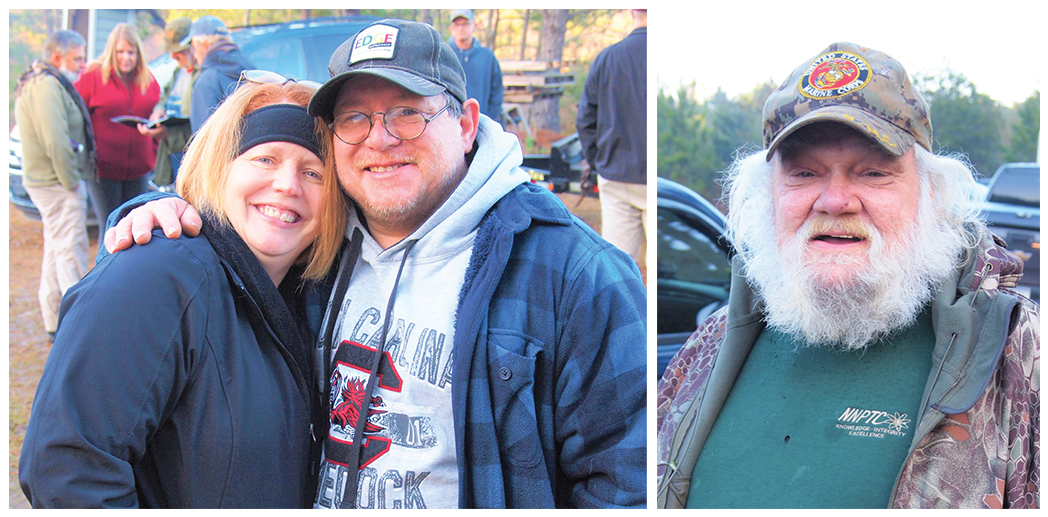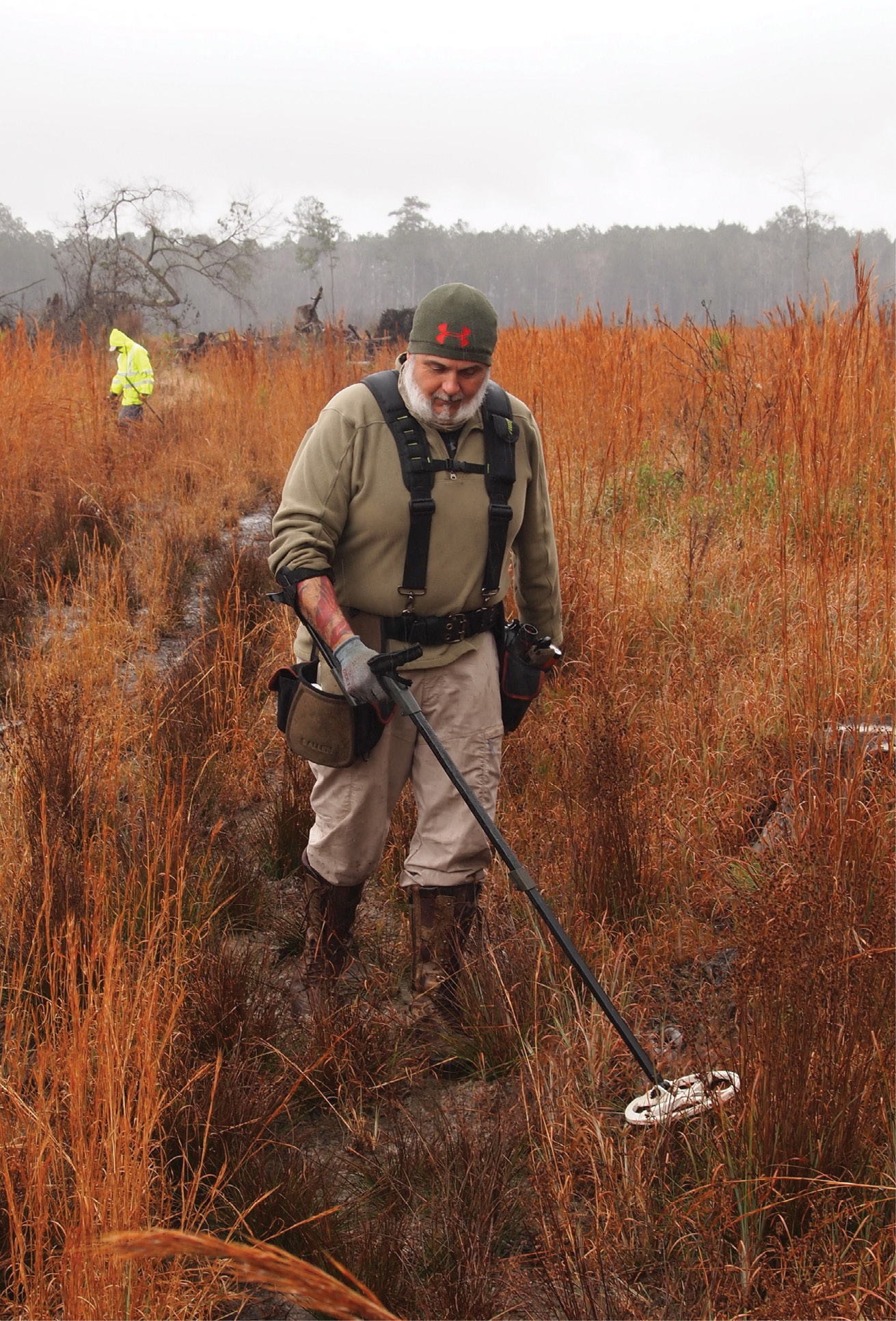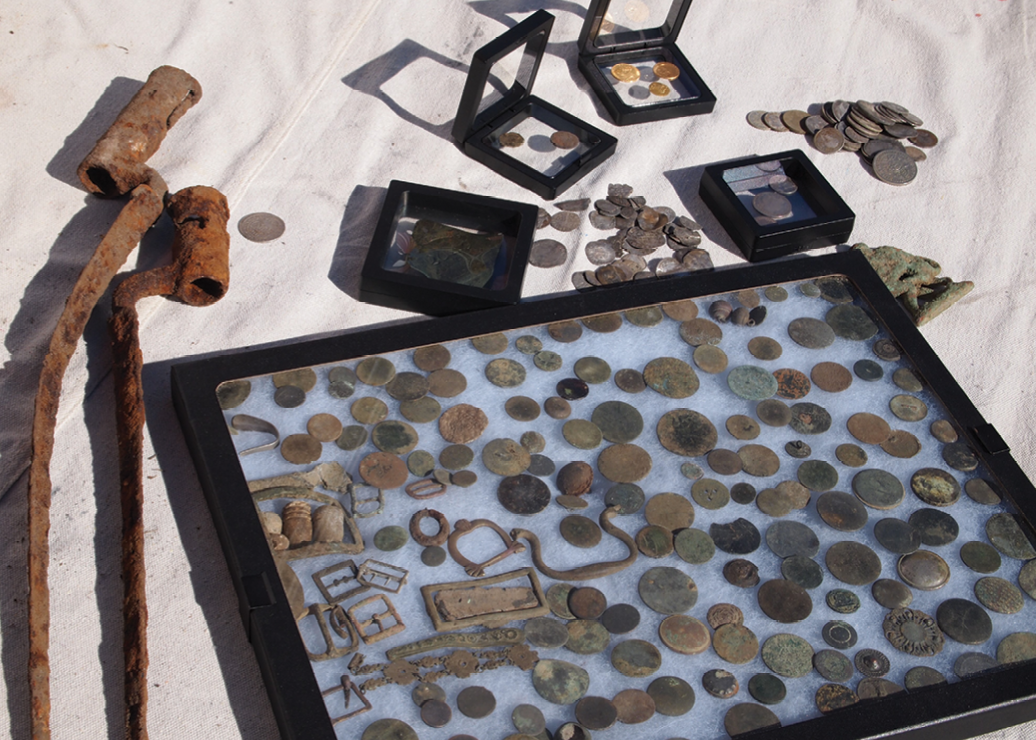A Day in the Life of a Metal Detecting Treasure Hunter James Jerdon

Somewhere around the late 1850s in the hamlet of Pineland, South Carolina, an unknown individual, probably a farmer, walked or rode a horse or sat atop a wagon along what was likely a wide open, cultivated field. Not knowing that a loose thread in his pocket had allowed a U.S. minted 1859 silver three-cent piece to fall to the ground, the farmer went on with his day, three cents poorer. It’s not so hard to imagine. Lost change is nothing new.
Some 160 years later, near that same spot in what is now heavily forested land, 49-year-old James Jerdon of Myrtle Beach listens intently through wireless headphones. As he swings a high-end metal detector inches from the ground, back and forth in a four-foot arc, something catches his attention; a telltale beep indicating metal. He pauses, zoning in on the area with the strongest signal. In less than a minute, Jerdon retrieves this same lost coin, finding it in 10 inches of sandy soil. Today’s value—around $75. This is why “hunters” or “diggers” (self-named metal detector enthusiasts) spend countless hours and plenty of their own spare change digging in the dirt.
7:30 a.m.
On a recent unusually cool and rainy weekend, I accompanied Jerdon to the Lowcountry to join around 60 other hunters, all members of the South Carolina Dirt Diggers, a club boasting some 200 members from all over the U.S. They each paid $150 for the privilege of hunting on hundreds of acres in rural Jasper County, southwest of Charleston, just north of Beaufort and the Georgia state line. The deal they struck with the landowner, not uncommon in the hobby, is one where the lion’s share of the entry fee goes to the landowner, and anything found by any individual hunter is theirs to keep.
“We’re not too far from where [U.S. General] Sherman and 15,000 troops marched through and possibly camped,” says landowner Darell Johnson, addressing the club, while his dog chases a plastic bottle at his feet. A small campfire warms the morning air as young and old, men and women, sip coffee, eat donuts and stand listening to club president Clyde “Sparky” Chilson, along with Johnson and a few others who offer tips and instructions. Rain would come later, but early on the sky was blue and the promise of unseen treasures drifted through the crowd.

7:42 a.m.
I’m introduced to a couple from Anderson, S.C., both new to the club and on their first “official” hunt. They had opted to tent camp at a nearby KOA and were getting the lay of the land at the early morning meeting.
“We took our brand new detectors to Florida last winter,” says Mandy Elmore, “and we found some lovely tin foil.” Husband John adds “…but in our yard at home, we found some silver quarters and some old tools. We did an internet search and found the club, and here we are. We hope to find some great relics, but it really doesn’t matter. I got the wife to go tent camping!”
Civil War relics are among the most common and highly coveted artifacts found, and each of the club members is an amateur historian, some with a surprising amount of knowledge. In the club for about a year, 68-year-old Glenn Watkins, from Cummings, G.A., is a walking, talking embodiment of history. Watkins has been a Civil War reenactor since the late 1970s and is an accomplished musician who still teaches. The burly man with a substantial white beard once played bass guitar in the bands of Neil Young, Willie Nelson, Hank Williams Jr., Bo Diddley, Travis Tritt and a dozen others. He’ll entertain the troops at the club’s Saturday evening campout on acoustic guitar. Regarding his chances on the hunt?
“I’d like to get something nice, but I’m really here for the adventure,” he says.
Clubs such as the Dirt Diggers research extensively using old maps, historical documents and anything that might help them pinpoint an old settlement, trade route or, in the case of today’s hunt, somewhere of historical significance, such as Sherman’s infamous March to the Sea in 1864. Johnson’s land is also a part of a long since forgotten plantation. The lands of S.C., and many of the Eastern states especially, are loaded with valuable (and not so valuable) metal artifacts; discarded military gear, lead Minnie ball bullets, farming implements, buttons, buckles, coinage and a wide variety of lost treasure dating back to well before the U.S. Revolution, including ill-gotten Spanish pirate booty…
“I own the oldest coin found on a club dig,” says Jerdon proudly. “It’s a 1712 Carlos III Four Reale. I found it on a dig near Columbia, S.C.”
This coin was minted in Madrid, Spain, in 1712 and somehow made it to Columbia, probably during the Revolutionary War era, when looted Spanish silver was used to back paper money (continentals) to fund the war effort. Jerdon has been in the hobby for around 20 years and has been on seven organized digs in Colchester, England, where he’s found his favorite artifacts, Celtic and Roman coins, the oldest dating back to 150 BC. He has scores of medieval coins dated between 1300–1500 AD.
8:15 a.m.
Before Jerdon dons his paramilitary gear, made up of a complicated harness, accoutrements, a small shovel, and several small bags and boxes, we drive a mile down the dirt road and spot a grove of hardwoods.
“When you see big old hardwoods, daffodils, a Holly bush or a stand of bamboo, that’s a sign that there may have been a homestead there,” he explains, meaning good hunting grounds. “All these woods weren’t here 150 or 200 years ago; they were clear cut for farmland. So the pines and the smaller trees aren’t as much of an indicator, but these 200-year-old oaks are.”
We meet club member Heidi Fisher, who’s traveled from her home in Boston to be a part of the club dig. Through the trees, we spot a few other hunters already at work. I note that some of the hunters swing their detectors (called “machines”) slowly, while others move about as fast as possible.
“That’s because of processor speed,” says Jerdon, referring to the brains of the machine that translates metal in the earth to beeps in your headphones. Less expensive machines have slower processors, requiring slower movements, though the end result is the same. Jerdon’s machine, while not the very top of the line, is considered a professional level detector.
“I guess I probably have around $7,000–$8,000 invested in gear,” he says. This includes backup detectors, pointers and duplicates of other essentials. “A decent beginner machine, with everything you need, is probably around $500,” he continues. “It’ll get you rolling down on the beach and into the woods and help you find something. Don’t even bother with the cheaper ones, “ he warns, “they’ll frustrate you.”
Out of the truck and suited up, Jerdon pairs a set of Bluetooth wireless headphones with his machine, and we’re off. While he wasn’t looking, I threw a quarter in the dirt, covered it with leaves and challenged him to find it, giving him a 10-square-foot area in which to hunt. Less than 20 seconds later, he picks it up from the ground.
“It’s mine now,” he says with a mischievous smile. “Finder’s keepers.”
8:44 a.m.
Having found a few shotgun shell brass casings, an old axe head and a half-dozen lead pistol balls (1800–1920), we stop to chat with Fisher and to compare finds. She’d also found a few pistol balls and “wheaties,” which are copper pennies (1909–1956) with wheat stalks on the back, but not much else.
“Tell him about your tree coins,” says Jerdon, Fisher’s face lighting up as she pulls her phone out to show me photographs.
“I was near Plymouth [M.A.],” she starts, retelling the story with the same enthusiasm and pride as the first hundred times she’s told the tale. “I was brand new [to the hobby] and had been hunting with a friend for a couple of hours near a river, just inland from the ocean. I got a hit that registered a coin, and started digging. I found this folded coin, bent in half, and retrieved it. I covered the hole and rescanned—that’s something you learn to do—and got another hit. This time I saw the coin with a tree image on it at the edge of the hole—my shovel had just missed it, thank God—I knew what it was the minute I found it; a tree coin.”
“Tree Coins,” also called “Pine Tree Shillings,” are so named for the minted tree image on one side. They were common in Colonial New England, and most are dated 1652, though they were produced for several years on either side of that date. Depending on the grade and other rarities in the minting, values for each can run between several hundred dollars to the tens of thousands. Fisher’s coins were graded at “five figures,” she says. The folded tree coin Fisher found would have been placed at each corner of a house to ward off evil spirits.
9:15 a.m.
Though nothing of great value or significance had yet to be found, we continue meandering through the woods with relaxed purpose. We spot plenty of filled-in holes where other hunters had just looked, dug and refilled the divots, leaving a fresh spot on the soil. The walk through the woods is pleasant, and I am reminded of the old fisherman’s motto with a slight variation. “Even a bad day relic hunting is better than a good day at work,” I say. Jerdon agrees, adding, “Ya never know what’s out there or where or if you’ll find it.” The worry of getting skunked doesn’t keep him from hunting every chance he gets. Jerdon is co-owner of a Grand Strand landscaping business, Carolina Diversified Property Maintenance, and during the slow times he’s out as often as possible. Jerdon’s wife, Melanie, an insurance agent, accompanied her husband early in his hobby career, but didn’t quite catch the fever. “No, she let’s me do this on my own,” Jerdon laughs. “She has her crafts and I have this, but I try not to push my luck.”

9:44 a.m.
Coming to a slight rise on the forest floor, and with plenty of fresh holes nearby, Jerdon gets a strong hit. He slows the swing of his machine and clears away the leaves with his booted foot. He places the loop of the detector (the round, flat sensing part of the device) over the spot, confirming a signal. Based on the sound and the numerical value displayed, he’s pretty sure it’s a coin. He grabs a small shovel from his harness. One quick dig and he’s unearthed a clod of sandy soil. He takes the pinpoint detector, about 15-inches long and the size and shape of a thick candle, which is also connected to his headphones. He runs the smaller handheld device through the freshly upturned soil, and, within a few seconds, he reaches into the dirt and pulls out the solid silver 1859 three-cent piece, nicknamed a “trime.”
We’ve scored with this. The trime is the size of a modern dime and it had laid undisturbed in the woods for who knows how long. Jerdon smiles, but isn’t giddy. He’s found lots of coins, many much older and more rare, but still it’s a solid find. He retrieves his phone to send a photo to the club president, who responds with his congratulations and news of other club finds, one at a site 10 miles down the road.
“They found a seated dime and a three-bander over by Early Branch,” he tells me, translating that a “seated dime” is a Liberty dime minted 1837–1891, depicting seated Lady Liberty. A “three-bander” is a Civil War era musket-fired Minnie ball with three bands around the outside.
10:10 a.m.
“It’s really a lot of luck,” says Jerdon. “You’re walking and walking and walking, and then you stumble upon something a foot away from where someone else had just been and didn’t catch it. Nothing is ever, or is rarely ever, hunted out.” We walk toward the truck, hunting our way as we near the road. “I like this time of year,” he says. “In the summer months it can be brutally hot, there’s poison ivy everywhere, and snakes. In 2019, I had poison ivy 13 times, poison oak once and poison sumac once.”

11:01 a.m.
As a light but steady rain descends, we drive to another site. We talk about a few ne’er-do-wells who operate on the periphery of the hobby.
“It’s unfortunate that a few guys can ruin it for the rest of us,” says Jerdon. “You’ve got to have permission from the property owner, and most property owners say no. That’s one of the reasons these clubs are so great; because of our numbers we can offer a landowner some significant financial incentives, which helps them, which helps us.” The laws regarding relic hunting are specific and can be severe, especially in Europe.
“In England, the Treasures Act of 1996 spells out the rules,” says Jerdon. “Basically, you have to have permission from the landowner and work out a deal in advance on sharing the value of anything found. Then, if you do find anything, the relic goes to the British government and the Natural History Museum in London, where it’s graded and valued. If the museum wants it, they’ll make you an offer. You can counter the offer, and they can decide then to keep it and pay you, or return it to you—unless it’s deemed of some major historical value. You pay tax on the appraised value, pay the landowner his share, and then it’s yours to take home.”
While England’s hunts are effectively shut down until the pandemic eases, hunts in the U.S. continue. Jerdon likes the S.C. hunts because of their proximity to home, but he recognizes the advantages of New England as well, having participated in several hunts there. “South Carolina didn’t keep great records back in the day,” he says, “but in Rhode Island or Mass you can pinpoint a house that was built in, say, 1625, and with a good GPS program get right on it.”
It was in Rhode Island that Jerdon retrieved several solid silver buttons and a 1723 King George I Hibernia coin, all just about six inches deep. Here at home he doesn’t bother with the beach, where many of us encounter hunters and watch curiously.

“Too many people want to come up and ask too many questions. I don’t have the patience for that; it screws up my rhythm,” he laughs. Jerdon would rather be in the woods or roaming through the hills of Great Britain; he’ll leave the beach to others.
12:15 p.m.
With the rain showing no interest in slowing, I make my leave. Jerdon will stay for the weekend and join the club in their campfire cookout, where tall tales, dreams of hordes of gold, live music and plans for future hunts are discussed over a few adult beverages.
On a side trip nearby a few days later, Jerdon found two Revolutionary War bayonets in his first five minutes of hunting. Many hunters have a “bucket list,” of finds, giving them something specific to look and hope for, but not Jerdon.
“I don’t have a bucket list,” he says. “I come for the fun of hunting.”
The South Carolina Dirt Diggers Club can be found on Facebook. Interested potential new members and landowners may contact the club’s administrators there.